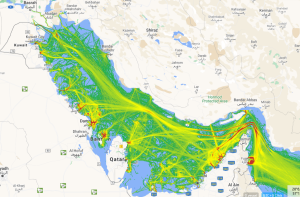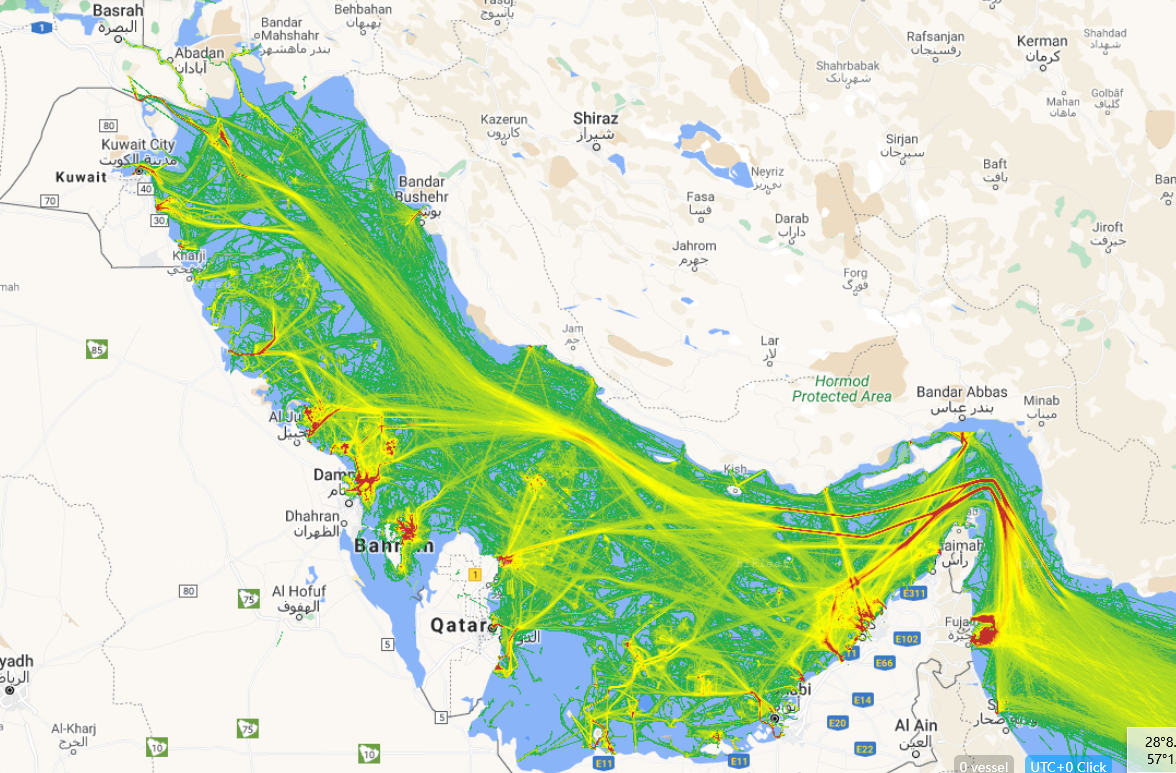Explore the evolving dynamics of tanker traffic in the Persian Gulf. Learn about current trends, geopolitical factors, environmental concerns, and what the future holds for one of the world’s busiest maritime regions.
The Persian Gulf is more than a body of water; it is the very pulse of global energy logistics. Every day, tankers—some of them hundreds of meters long—sail through this narrow sea, carrying millions of barrels of oil and liquefied natural gas (LNG) to ports around the world. For decades, this region has served as a lifeline for international energy markets and maritime trade. But recent developments—ranging from geopolitical tensions to technological innovation and climate considerations—are reshaping the patterns of tanker traffic in the Gulf.

Why Tanker Traffic in the Persian Gulf Matters in Modern Maritime Operations
The Persian Gulf sits at the heart of the global fossil fuel economy. Countries like Saudi Arabia, Iran, the United Arab Emirates, Kuwait, and Qatar account for a significant portion of the world’s crude oil and LNG exports. The United Nations Conference on Trade and Development (UNCTAD) reports that nearly 21% of global petroleum liquids pass through the Strait of Hormuz, the narrow gateway connecting the Persian Gulf to the Oman Sea, Indian Ocean, and beyond (UNCTAD, 2024).
This isn’t just about quantity; it’s about dependency. From China and India to Japan and South Korea, Asian economies rely heavily on Gulf energy supplies. That makes tanker movement through this region not only a commercial necessity but also a strategic vulnerability. If traffic here stalls, energy markets ripple worldwide.
–
Key Trends in Tanker Movement Through the Persian Gulf
Increasing LNG Traffic
While oil still dominates, liquefied natural gas (LNG) exports are rising. Qatar’s Ras Laffan port, one of the largest LNG export terminals globally, is undergoing further expansion under the North Field East project, expected to boost output by 40% by 2027 (Qatargas, 2024). Modern LNG tankers, often dual-fuel and equipped with boil-off gas recovery systems, are becoming a more common sight in Gulf waters.
VLCC and ULCC Utilization
The Persian Gulf regularly accommodates Very Large Crude Carriers (VLCCs) and Ultra Large Crude Carriers (ULCCs), thanks to specialized loading terminals like Ras Tanura (Saudi Arabia) and Kharg Island (Iran). These vessels often transport more than 2 million barrels of oil in a single voyage. Their use maximizes cost efficiency, though it also raises port access and maneuverability challenges in the Gulf’s shallow and busy waters.
Shift in Trade Patterns
Amid Western sanctions on Russian oil, Gulf producers have deepened ties with Asian and African markets. This is reflected in changing AIS data showing increased tanker activity bound for India, Bangladesh, and East Africa. The Gulf is no longer just feeding traditional markets—it’s adapting to a new global trade geography.
Tanker Tracking and Maritime Domain Awareness
Digital technologies like AIS (Automatic Identification Systems) and platforms like MarineTraffic and Lloyd’s List Intelligence now enable real-time tracking of tanker movements. Governments and shipping companies use this data for logistics, while security analysts monitor suspicious patterns to detect smuggling or sanctioned shipments.
–
Geopolitical and Security Factors Affecting Tanker Traffic
The Persian Gulf is geopolitically fragile. Naval confrontations, drone attacks, and tanker seizures are not rare. In 2019, multiple incidents—including the seizure of the Stena Impero by Iran—heightened global tension and raised insurance rates for tankers in the Gulf.
The U.S. Fifth Fleet and allied naval forces continue to patrol the region, often coordinating through coalitions like Operation Sentinel. Meanwhile, Iran frequently conducts military exercises near the Strait of Hormuz to showcase regional control.
A recent report from the International Chamber of Shipping (ICS) emphasized the need for continued multilateral cooperation to ensure Freedom of Navigation (FoN) in the Gulf’s narrow shipping lanes.
–
Environmental Impact of Heavy Tanker Traffic
Shipping density in the Persian Gulf makes it a hotspot for environmental risk:
- Ballast water discharge introduces invasive species.
- Oil spills, although infrequent, pose catastrophic ecological threats due to enclosed sea conditions.
- Thermal pollution from tankers and nearby industrial activity (like desalination plants) leads to marine habitat disruption.
The Marine Pollution Bulletin (Elsevier, 2023) noted that the Gulf has witnessed a 15% rise in hydrocarbon traces in its water column over the past decade.
IMO regulations, such as MARPOL Annex I (oil pollution) and Annex VI (air pollution), are strictly enforced at Gulf ports. Ports like Jebel Ali and Fujairah have installed modern reception facilities and deploy oil recovery vessels for emergency response.
–
Technological Developments and Smart Shipping
Smart shipping and emissions-reducing technologies are becoming more common among tankers operating in the Gulf:
- Scrubber systems and LNG propulsion are now standard for new builds, helping shipowners comply with IMO 2020 sulfur limits.
- Autonomous navigation systems are being tested in pilot zones, including near Abu Dhabi and Ras Al Khaimah.
- Blockchain-based cargo tracking, implemented by DP World in Dubai, improves transparency and efficiency for oil and LNG logistics.
The DNV Maritime Forecast to 2050 (2024 edition) predicts that tankers in the Gulf will increasingly shift toward zero-carbon fuels, including ammonia and methanol, by the early 2030s.
–
Case Study: VLCC Navigation Near the Strait of Hormuz
Navigating a 330-meter-long VLCC through the Strait of Hormuz is no small feat. A single misstep in this 21-mile-wide strait—with just **2 miles of navigable channel in each direction—**could block global oil flows.
During high-tension periods, VLCCs often rely on naval escorts or join convoys, particularly when transiting from Iran’s Kharg Island or Saudi Arabia’s Ras Tanura. Port State Control and VTS systems in the area monitor their paths closely.
In 2023, the MT Ghazal, a Bahrain-flagged VLCC, demonstrated the use of AI route optimization software to avoid congestion while reducing fuel consumption by 4.2% during a round trip to Singapore.
–
Challenges and Mitigation Strategies
- Geopolitical Risk: Investment in risk forecasting systems and war risk insurance is crucial. Many operators subscribe to Inmarsat’s Fleet Secure for cyber and navigation protection.
- Port Congestion: Larger ships and increased traffic have led to delays. Just-in-time arrival systems and slot-booking AI algorithms at Jebel Ali and Ras Laffan help manage flow.
- Environmental Pressure: Adoption of Emission Control Areas (ECAs) in regional planning is under consideration by the Regional Organization for the Protection of the Marine Environment (ROPME).
–
Future Outlook for Tanker Traffic in the Persian Gulf
Several long-term trends are likely to shape the region’s future:
- Diversification of Export Routes: Saudi Arabia’s East-West pipeline and the UAE’s Fujairah terminal offer options that bypass the Strait of Hormuz, reducing risk.
- Green Shipping Corridors: Talks between Gulf countries and international organizations like the IMO and ICS are underway to establish green shipping lanes, potentially integrating renewable-powered tugs and cold-ironing at port.
- Hydrogen Economy: Tankers adapted to carry liquid hydrogen or ammonia may emerge within the next 10-15 years, as Gulf nations like Saudi Arabia invest in hydrogen production.
- Smart Maritime Infrastructure: Ports in Dubai and Abu Dhabi continue to lead with digital twins, AI cargo optimization, and automated berth scheduling.
According to the UNCTAD Review of Maritime Transport 2024, tanker throughput at Gulf ports grew by 5.7%, driven largely by increased demand in Southeast Asia.
FAQ
Why is tanker traffic in the Persian Gulf so important globally?
Because nearly one-fifth of the world’s oil and gas exports transit through this region, supporting global energy supply chains.
What is the main chokepoint for tankers in the Persian Gulf?
The Strait of Hormuz, only 21 miles wide at its narrowest, handles a significant share of global tanker traffic.
Are modern tankers environmentally friendly?
Many new tankers are equipped with scrubbers, dual-fuel engines, and ballast water treatment systems to reduce emissions and pollution.
How is technology improving tanker efficiency in the Gulf?
Technologies like AI routing, blockchain tracking, and smart port scheduling are reducing costs and emissions.
What countries dominate tanker operations in the Persian Gulf?
Saudi Arabia, Qatar, UAE, Iran, and Kuwait are key players, both as exporters and port operators.
Are alternative shipping routes viable?
Yes, but they are limited. Pipelines like the Petroline and ports like Fujairah offer partial alternatives.
Conclusion
Tanker traffic in the Persian Gulf is not merely a matter of maritime logistics—it is an essential pillar of the global economy, balancing energy demand, geopolitical complexity, and environmental responsibility. As the world transitions toward cleaner fuels and digital infrastructure, the Gulf’s maritime actors must stay adaptive and resilient.
In the years ahead, smart tankers, green corridors, and multilateral cooperation will likely define the future of tanker traffic in the region. Whether you are a maritime student, industry expert, or just a curious observer, understanding the dynamics of tanker movement in the Persian Gulf is essential to grasping the broader story of modern shipping.
References
- UNCTAD (2024). “Review of Maritime Transport.” unctad.org
- Marine Pollution Bulletin, Elsevier (2023). ScienceDirect
- Qatargas (2024). “North Field Expansion Project.” qatargas.com
- ICS (2023). “Freedom of Navigation and Maritime Security.” ics-shipping.org
- DNV (2024). “Maritime Forecast to 2050.” dnv.com
- MarineTraffic (2024). “Live AIS Ship Tracking.” marinetraffic.com
- Lloyd’s List Intelligence (2024). “Global Tanker Movements.” lloydslist.maritimeintelligence.informa.com
- BIMCO (2023). “Tanker Outlook.” bimco.org
- The Nautical Institute (2024). “Tanker Safety and Navigation.” nautinst.org
- ROPME (2024). “Marine Environment Protection in the Gulf.” ropme.org

